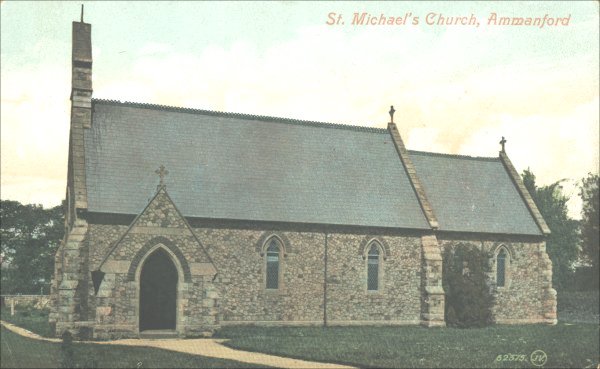ST
MICHAEL'S AND ALL ANGEL'S CHURCH
(SAN
MIHANGEL A'R HOLL ANGYLION)
(scroll down for history)

Until 1911 the two parochial church parishes in the Amman Valley area were Llandybie and Betws, with the river Amman providing the boundary between them. Ammanford was part of the Parish of Llandybie, at least for religious purposes, but its churchgoers had to use nearby Betws church for their worship, even though Ammanford had long outgrown Betws in population. Ammanford had grown so rapidly with the influx of people seeking work in the expanding mining and tinplate industries that the existing places for church worship could not accommodate them. There were plenty of chapels in Ammanford by the late nineteenth century but no church. To overcome the problem the vicar of Llandybie, a Reverend David Davies, negotiated an agreement for the use of Watcyn Wyn's old schoolroom in Brynmawr Lane (now the English Baptist Church) as a place of worship for Ammanford churchgoers. This was finally dedicated by the Bishop of St David's in May 1882, the church to be known as Saint Michael's and All Angel's Church, and the Reverend David Davies held the first church services there.
With the population still increasing there soon came a need for a larger building and by 1885 a new church was built and dedicated on its present spot in Wind Street. The funds were raised locally and the new church was built on land donated by Lord Dynevor, adopting the name given to the Watcyn Wyn building of Saint Michael's and All Angel's Church, or San Mihangel a'r holl Angylion in Welsh.
St Michael's Church was built according to a similar layout as St David's Betws, with a nave without aisles, a chancel, entrance and bellcote. The church was built in an unusual style of masonry known as Kentish Rag, each spilt stone being of uniform size and hand picked from the river Amman.
A Church Hall to be used for Sunday schools and meetings of church members was added just across the road in 1900. But at first the congregations for St Michael's were so large that the Church Hall had to be used as an overspill venue with the help of lay readers to conduct the services. It soon became evident that an even larger premise was needed and All Saints Church was eventually built in 1915. In just 30 years, Ammanford had gone from having no church at all to the envious position of enjoying two of them.
In 1910 Kelly's Directory for South Wales' describes Ammanford, including St Michael's church, thus:
The parish [ie Ammanford] is governed by an Urban District Council of 15 members, formed in 1903, under the provisions of the Local Government Act, 1894. The town is lighted by electricity supplied by the Ammanford Electric Supply. The church of St. Michael's and All Angels, erected in 1885, at a cost of £1,257.7s.7d. is an edifice in the Early English style, consisting of chancel, nave, vestry, and a bell cot, containing one bell. There are 200 sittings ... There are Wesleyan, Baptist, Congregational and Calvinistic Methodist chapels. In the parish are tinplate works and collieries. The Ivorites Hall is used for concerts, theatricals and public meetings, and will seat about 1,600 persons. A market is held here every Saturday. Brynffin is the property and residence of Lieut.-Col. David Morris. The Hon. W. F. Rice, Mrs. Jones of Carregamman, and W. N. Jones esq. J.P., are the principal landowners. The area is 878 acres; rateable value, £11,491; the population in 1901 was 3,500 and is now [ie in 1910] about 6,000.
The problem of which language to conduct services in was also resolved with the building of this new church. All Saints would henceforth conduct its services for the benefit of an English speaking congregation with St Michael's being dedicated to the Welsh speakers of the town.
When a new Urban District Council was created in 1903 by merging the villages of Llandybie, Ammanford and Betws the name given to the new creation was Ammanford Urban District Council in recognition that Ammanford was now the senior partner, both in population and economic importance. Not so however with the Church authorities when they decided to redraw the parish boundaries in 1911 to place Ammanford, which had previously been part of Llandybie Parish, in the same parish as Betws. The new parish was to be called Betws-cum-Ammanford (Betws with Ammanford) and not the other way around. The smaller village of Betws was asserting its much older history over the larger but younger Ammanford, with age clearly taking precedence over mere size. God knows better than the electorate, the church authorities would seem to be saying, and who are mere mortals to disagree?
The website for the parish of Betws with Ammanford (All Saints church, Ammanford; St Michael's, Ammanford; St David's, Betws; St Thomas, Wernoleu) can be found on: Parish of Betws with Ammanford.
